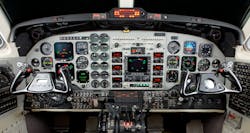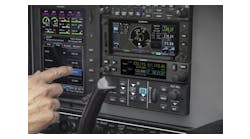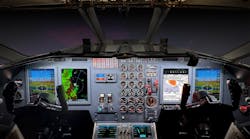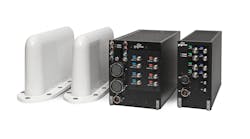Most tried and true airplanes have any number of aftermarket modifications and upgrades available and the Beechcraft King Air is one of them. The first airplane in its class the King Air line of aircraft has been in continuous production since the early 1960s beginning with the Model 90 and 100 series.
Later the larger siblings came along, the 200 and 300 series, which were originally marketed as the Super King Air family, and this line has been in continuous production since 1974. In 1996 the distinction “Super” was dropped by Beechcraft, although many are still known to use the name Super to differentiate them from the smaller airframes.
Some of the typical upgrades and modification have been engine and propeller upgrades, cargo conversions with a larger rear door, wing spar modifications, larger baggage compartment in the nose section and engine nacelle compartments, and many more including of course avionics upgrades.
The Garmin G1000 Suite
When it comes to the flight deck one can argue a strong case that perhaps the ultimate King Air upgrade so far may be the Garmin G1000 retrofit. The G1000 suite integrates all primary flight, navigation, weather, terrain, traffic, radio frequency, and engine and fuel data readouts on large-format, high-definition liquid crystal displays (LCD).
The cockpit layout features a 15-inch multi-function display (MFD) in the center, and 10.4-inch primary flight displays (PFDs) at the pilot and copilot positions. The G1000 system for the King Air also includes the GFC 700, a three-axis, fully digital, dual-channel, fail passive Automatic Flight Control System (AFCS) capable of using all data available to G1000.
Another offering is the Electronic Stability and Protection (ESP), an option for new King Air 200, 300, and 350 series retrofits. The ESP is designed to provide another layer of protection when the pilot is hand flying the aircraft by applying a gentle corrective force to the yoke when it detects excessive pitch and roll. And there’s more. Because the G1000 integrates so many components into one system, depending on the model, most airplanes can see a weight savings of at least 200 pounds, 65 of which relates to the wiring harness alone. Garmin holds the Supplemental Type Certificate (STC) for the G1000 upgrade to the King Air C90B, 200, B200, 300, and 350 models.
The Elliott Aviation install
To understand more of the installation, I visited Elliott Aviation in Moline, IL. Mark Wilken, director of avionics sales, describes the program. “We began the program in 2009 and today we accomplish two to three G1000 King Air upgrades per month and are currently celebrating accomplishment of 75 aircraft.”
He goes on to say that in order to understand why this program has been such a success you need to go back a couple decades. Wilken says, “As we all know technology has driven dramatic changes in avionics. It seems like not long ago we had round-dial mechanical instruments. Then in the early 1980s the cathode ray tube (CRT) became a standard in cockpits and continued into the last decade. But what happens when your CRT eventually fails? Replacement costs are high. Some operators are known to have spent upwards of $20,000 per year for avionics maintenance and component replacement costs. At what point do owners and operators say enough.” He goes on to describe how the consumer electronics industry transitioned to LCDs and the CRT really became obsolete. “In aviation the similar took place and obsolescence of certain electrical components drives upgrades. I believe this is when Garmin stepped into the scene,” Wilken says.
Jon Young, avionics lead technician, gave me a demonstration on the Elliott King Air G1000 simulator. Although I am a pilot, I’m not current on modern avionics systems and rapidly became overwhelmed by all the available functions. It was clear the system has the capability to do most anything. Young, who holds an Avionics Repairman Certificate and Private Pilot Certificate, demonstrates the G1000 capabilities to all pilots considering or upgrading King Airs. Young flies with the flight crews after the install to demonstrate and educate pilots on the system. Yes, that’s correct, the technician teaches the pilot.
A well-choreographed dance
Jeff Dean, one of the G1000 service team leads and holder of an A&P/IA, says it really begins when an airplane arrives before it ever comes into the hangar with a very comprehensive incoming acceptance check. Dean explains how they accomplish a complete check of all the systems in the airplane, not just the avionics. The induction checks include power runs to check all of the engine instruments and indications, a pitot-static system check, all the way to verifying the position and that cabin lights work correctly.
Dean says, “When the aircraft comes into the hangar, we know everything about it. We do not want an airplane going into final check outs with any problem that we are not aware of.” The aircraft is defueled for weight and balance purposes done later in the program and it’s jacked and leveled. Areas of the aircraft tail section are checked for hidden magnetism that later may affect new sensors located there.
All the technicians involved go through two days of Garmin G1000 maintenance training which provides an overview of the system and typical fault troubleshooting practices. The STC and installation instructions have very specific requirements for even the little things like exact wire termination methods or wire shield lengths.
Elliott uses dedicated teams of technicians specializing in fabrication and installation such as the interior team, structural team, wiring harness fabrication, harness installation, and system check-out and flight test. Each team and the technicians have goals and sub-goals and the install teams have even developed a friendly competition with each other. Elliott Aviation fabricates as much of the individual piece-parts as possible in-house and feels fabricating in-house provides much better control of the quality and the overall aircraft downtime.
Dean’s team supports the systems maintenance portion and he walked me through a few portions of the program. He described the G1000 as having numerous sensors located throughout the aircraft for any number of systems like the engines, landing gear and flap position indication, flight controls, autopilot systems, and more. All of the autopilot servos are removed and replaced. It’s not just an avionics package in the traditional sense of installing new communication and navigation radios. Dean says, “Because the G1000 is totally integrated into the aircraft, all of the analog transmitters are removed and new data transmitters installed. Synchronizing the engine displays after installation can be a challenge.”
Dean explains the digital displays have a much greater accuracy of readings than the traditional analog instrumentation and transmitter units. On the analog gauges the pilot may not have been concerned with or even noticed a slight difference between say the left and right needles for a 3-psi difference in oil pressure, a 5-rpm difference between the left and right propellers, or a 10-degree difference in the turbine inlet temperature between the left and right engines. These slight differences are now clearly recognized on the digital display even though the difference may have always been there. “Some pilots now become very particular with this and at times trying to make these types of exact adjustments is like opening Pandora’s Box; one adjustment may affect several other data points,” Dean says.
When I asked Wilken what has made this program a success for Elliott he mentions a couple items. “First the King Air is a great platform for the G1000 upgrade. The airframe ages very well and lends itself toward continual upgrades so an upgrade to a new technology flight deck works well.” Next, he says, “It’s our recipe” – but stops short of describing too many of the details of what goes into that recipe. He sums up by saying, “It’s a well-managed program and a well-choreographed dance by the technicians.”
Dean closes by saying, “To wow the customer is the greatest challenge and the greatest reward. I love doing this; it’s a really fun job!”
More information can be found at www.elliottaviation.com and www.garmin.com.



